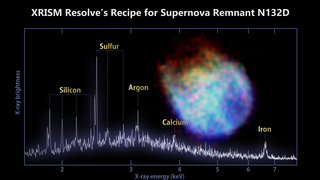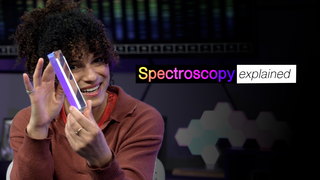XRISM Spots Iron Fingerprints in Nearby Active Galaxy

The Resolve instrument aboard XRISM (X-ray Imaging and Spectroscopy Mission) captured data from the center of galaxy NGC 4151, where a supermassive black hole is slowly consuming material from the surrounding accretion disk. The resulting spectrum reveals the presence of iron in the peak around 6.5 keV and the dips around 7 keV, light thousands of times more energetic that what our eyes can see. Background: An image of NGC 4151 constructed from a combination of X-ray, optical, and radio light.
Credit: Spectrum: JAXA/NASA/XRISM Resolve. Background: X-rays, NASA/CXC/CfA/J.Wang et al.; optical, Isaac Newton Group of Telescopes, La Palma/Jacobus Kapteyn Telescope; radio, NSF/NRAO/VLA
Alt text: A XRISM spectrum of NGC 4151 with a multiwavelength snapshot of the galaxy in the background.
Descriptive text: The spectrum image is labeled, “XRISM Resolve Spectrum of NGC 4151.” It shows a graph where the bottom is labeled, “X-ray energy (keV),” with a range from 5 to 9. The left side is labeled, “X-ray brightness.” A squiggly white line starts just under halfway up the left side. It peaks at just under 6.5 keV, nearly reaching the top of the graph. Then it starts to slope gently downward, with several sharp dips around 7 keV. In the background is a dim image of galaxy NGC 4151, where the center is a whiteish blue, surrounding by clouds of red and yellow.
After starting science operations in February, Japan-led XRISM (X-ray Imaging and Spectroscopy Mission) studied the monster black hole at the center of galaxy NGC 4151.
XRISM’s Resolve instrument, a microcalorimeter spectrometer, captured a detailed spectrum of the area around the black hole. The peaks and dips are like chemical fingerprints that can tell scientists what elements are present and reveal clues about the fate of matter as it nears the black hole.
NGC 4151 is a spiral galaxy around 43 million light-years away in the northern constellation Canes Venatici. The supermassive black hole at its center holds more than 20 million times the Sun’s mass.
The galaxy is also active, which means its center is unusually bright and variable. Gas and dust swirling toward the black hole form an accretion disk around it and heat up through gravitational and frictional forces, creating the variability. Some of the matter on the brink of the black hole forms twin jets of particles that blast out from each side of the disk at nearly the speed of light. A puffy donut-shaped cloud of material called a torus surrounds the accretion disk.
The galaxy is uncommonly bright in X-rays, which made it an ideal early target for XRISM.
Resolve’s spectrum of NGC 4151 reveals a sharp peak at energies just under 6.5 keV (kiloelectron volts) — an emission line of iron. Astronomers think that much of the power of active galaxies comes from X-rays originating in hot, flaring regions close to the black hole. X-rays bouncing off cooler gas in the disk causes iron there to fluoresce, producing a specific X-ray peak. This allows astronomers to paint a better picture of both the disk and erupting regions much closer to the black hole.
The spectrum also shows several dips around 7 keV. Iron located in the torus caused these dips as well, although through absorption of X-rays, rather than emission, because the material there is much cooler than in the disk. All this radiation is some 2,500 times more energetic than the light we can see with our eyes.
Iron is just one element XRISM can detect. The telescope can also spot sulfur, calcium, argon, and others, depending on the source. Each tells astrophysicists something different about the cosmic phenomena scattered across the X-ray sky.
XRISM (pronounced “crism”) is led by JAXA (Japan Aerospace Exploration Agency) in collaboration with NASA, along with contributions from ESA (European Space Agency). It launched Sept. 6, 2023. NASA and JAXA developed Resolve.

Image of NGC 4151 X-ray spectrum.
Credit: JAXA/NASA/XRISM Resolve

This composite image shows the central region of the spiral galaxy NGC 4151. In the center, X-rays (blue) from the Chandra X-ray Observatory are combined with optical data (yellow) showing positively charged hydrogen from observations with the 1-meter Jacobus Kapteyn Telescope on La Palma in the Canary Islands. The red around the center shows neutral hydrogen detected by radio observations with the National Science Foundation's Very Large Array in New Mexico. This neutral hydrogen is part of a structure near the center of NGC 4151 that has been distorted by gravitational interactions with the rest of the galaxy and includes material falling toward the center of the galaxy. The yellow blobs around the red ellipse are regions where star formation has recently occurred.
Credit: X-rays, NASA/CXC/CfA/J.Wang et al.; optical, Isaac Newton Group of Telescopes, La Palma/Jacobus Kapteyn Telescope; radio, NSF/NRAO/VLA

This artist’s concept shows the possible locations of iron revealed in XRISM’s X-ray spectrum of NGC 4151. Scientists think X-ray-emitting iron is in the hot accretion disk, close to the black hole. The X-ray-absorbing iron may be farther away, in a cooler cloud of material called a torus.
Credit: NASA's Goddard Space Flight Center Conceptual Image Lab
Alt text: A labeled diagram showing key components of an active galaxy.
Descriptive text: This image shows the center of an active galaxy. The black hole is hidden within the bright yellow-white region at center. It’s labeled “Black Hole: Object 20 million times the Sun’s mass at the galaxy’s center.” The black hole is surrounded by a yellow and orange structure. It’s labeled, “Accretion Disk: Flattened, swirling, superheated cloud where iron emits X-rays.” This, in turn, is embedded within a circular dark cloud. It’s labeled, “Torus: Cooler, puffy, donut-shaped cloud where iron absorbs X-rays.” A white line extends from just above the black hole to the picture’s top edge. It’s labeled, “Jet: Beam of particles moving at near light speed.” A scale bar stretching from the black hole to the torus reads "5 light-years."

Same as the above, but without labels.
Credit: NASA's Goddard Space Flight Center Conceptual Image Lab
For More Information
Credits
Please give credit for this item to:
NASA's Goddard Space Flight Center
-
Producer
- Sophia Roberts (Advocates in Manpower Management, Inc.)
-
Technical support
- Aaron E. Lepsch (ADNET Systems, Inc.)
-
Science writers
- Jeanette Kazmierczak (University of Maryland College Park)
- Francis Reddy (University of Maryland College Park)
Release date
This page was originally published on Wednesday, May 8, 2024.
This page was last updated on Wednesday, May 8, 2024 at 9:24 AM EDT.


